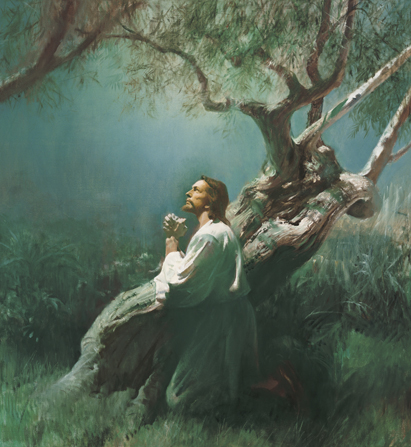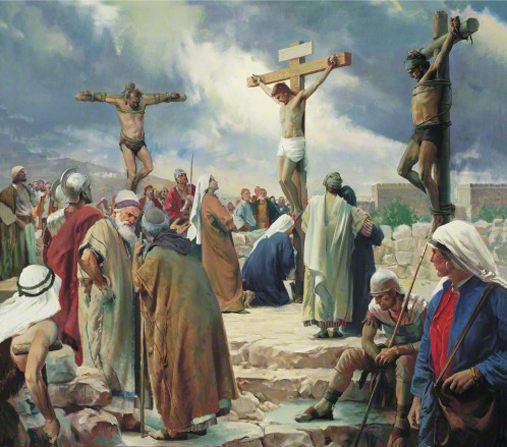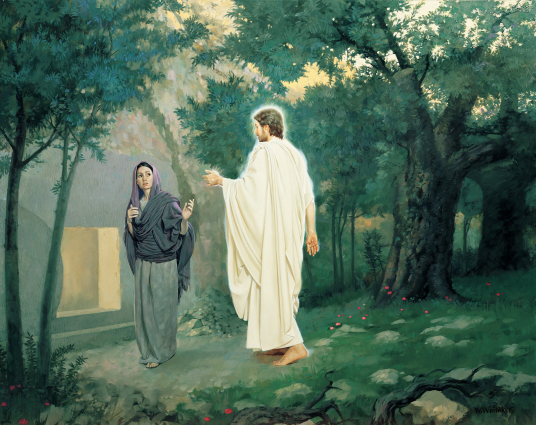The Easter bunny will not be visiting our house this year. It will be a monumental change for me (and my family), but with my oldest graduating from high school and my youngest leaving elementary school, our Easter celebrations have taken on greater meaning and focus on what the holiday is all about.
Don’t get me wrong, our Easter bunny always believed in and celebrated Jesus Christ. In fact, when they were younger, my kids were certain that he was a member of The Church of Jesus Christ of Latter-day Saints (sometimes mistakenly called the Mormon Church), as are we, because of the gifts that the Easter bunny would bring. But the bunny takes focus off the Savior. And since the prophets and apostles of The Church of Jesus Christ have been encouraging members to renew their focus on the Savior, I decided that our Easter festivities should as well. Because although the candy and treats are fun, but do they really help us find the true meaning in our celebration?
I have tried to tie the Savior into our bunny festivities, but they still detract from the true meaning of Easter. Our celebration of Jesus Christ can stand on its own without the fluff and frills, because He has done so much for us. Let me explain.
The Savior’s Divine Role
To fully understand the extent of what Jesus Christ has done for us, we must understand who He is. The prophets and apostles of The Church of Jesus Christ testified,
He was the Great Jehovah of the Old Testament, the Messiah of the New. Under the direction of His Father, He was the creator of the earth. “All things were made by him; and without him was not any thing made that was made” (John 1:3). Though sinless, He was baptized to fulfill all righteousness. He “went about doing good” (Acts 10:38), yet was despised for it. His gospel was a message of peace and goodwill. He entreated all to follow His example. He walked the roads of Palestine, healing the sick, causing the blind to see, and raising the dead. He taught the truths of eternity, the reality of our premortal existence, the purpose of our life on earth, and the potential for the sons and daughters of God in the life to come.
He instituted the sacrament as a reminder of His great atoning sacrifice. He was arrested and condemned on spurious charges, convicted to satisfy a mob, and sentenced to die on Calvary’s cross. He gave His life to atone for the sins of all mankind. His was a great vicarious gift in behalf of all who would ever live upon the earth.
We solemnly testify that His life, which is central to all human history, neither began in Bethlehem nor concluded on Calvary. He was the Firstborn of the Father, the Only Begotten Son in the flesh, the Redeemer of the world.
Our Easter celebrations must begin by recognizing His divinity, which allowed Him to accomplish His mission.
The Premortal Messiah
Jesus Christ was chosen from the foundation of the world for His divine role. President Russell M. Nelson taught,
Under the direction of the Father, Jesus bore the responsibility of Creator. His title was “the Word,” spelled with a capital W (see Joseph Smith Translation, John 1:16, Bible appendix). In the Greek language of the New Testament, that Word was Logos,or “expression.” It was another name for the Master. That terminology may seem strange, but it is appropriate. We use words to convey our expression to others. So Jesus was the Word, or expression, of His Father to the world. (See John 1:3; see also Doctrine & Covenants 93:21).
Jesus Christ truly was the expression of God’s love for the world. In everything that He did, in everything He taught, in everything He was, Jesus testified of our Heavenly Father and showed us the way back to Him. Elder Bruce R. McConkie explained,
For four thousand long years—from the day Adam was cast out of Eden to the day John baptized at Bethabara—all of the prophets and all of the Saints looked forward to the coming of the Messiah.
They talked and taught of Christ; they preached and prophesied of Christ; they centered their lives and all of their hopes in the promise of his coming.
They knew that as God’s Son he would be born of a virgin, that he would work out the infinite and eternal atonement, that immortality and eternal life would come by him.
All of their doctrine, all of their ordinances, all of their worship linked his name with that of the Father himself.
The whole law of Moses, with all its types and shadows, testified of the one who would come to save his people.
Christ’s Mortal Ministry
Recognizing who Jesus Christ is and all that He did for us before He ever walked the earth, it’s humbling that He chose to do so. He was the Creator of the world and Jehovah, the God of the Old Testament, and He condescended to be born of a mortal woman and Heavenly Father so that He could fulfill His mission as the Savior of all mankind. Elder Joseph B. Wirthlin said,
The birth of the Savior into mortality is an event of immeasurable significance that occurred almost 2,000 years ago. In much of the world, calendar years are numbered forward and backward from the entire time of His birth. … His teachings established standards of human behavior that will endure eternally.
He taught these standards of behavior in word and deed. President Nelson said,
His exemplary life constituted His mortal ministry. It included His teachings, parables, and sermons. It encompassed His miracles, loving-kindness, and long-suffering toward the children of men (see 1 Nephi 19:9). It embraced His compassionate use of priesthood authority. It included His righteous indignation when He condemned sin (see Romans 8:3) and when He overthrew the tables of the money changers (see Matthew 21:12). It also included His heartaches. He was mocked, scourged, and disowned by His own people (see Mosiah 15:5)—even betrayed by one disciple and denied by another (see John 18:2–3, 25–27).
Elder Richard G. Scott taught,
The greatest example who ever walked the earth is our Savior, Jesus Christ. His mortal ministry was filled with teaching, serving, and loving others. He sat down with individuals who were judged to be unworthy of His companionship. He loved each of them. He discerned their needs and taught them His gospel.
And He taught us to do the same.
The Mission of Jesus Christ
Jesus Christ’s mortal ministry culminated in the single most important event in human history, the event that we celebrate at Easter. Elder Dieter F. Uchtdorf explained,
To find the most important day in history, we must go back to that evening almost 2,000 years ago in the Garden of Gethsemane when Jesus Christ knelt in intense prayer and offered Himself as a ransom for our sins. It was during this great and infinite sacrifice of unparalleled suffering in both body and spirit that Jesus Christ, even God, bled at every pore. Out of perfect love, He gave all that we might receive all. His supernal sacrifice, difficult to comprehend, to be felt only with all our heart and mind, reminds us of the universal debt of gratitude we owe Christ for His divine gift.
The Savior’s mission was essential for us to return back to the presence of our Heavenly Father. President Nelson taught,
His mission was the Atonement. That mission was uniquely His. Born of a mortal mother and an immortal Father, He was the only one who could voluntarily lay down His life and take it up again (see John 10:14–18). The glorious consequences of His Atonement were infinite and eternal. He took the sting out of death and made temporary the grief of the grave (see 1 Corinthians 15:54–55). … Not only was it to provide for the resurrection and immortality of all humankind, but it was also to enable us to be forgiven of our sins—upon conditions established by Him. Thus His Atonement opened the way by which we could be united with Him and with our families eternally. This prospect we esteem as eternal life—the greatest gift of God to man (see Doctrine & Covenants 14:7).
Garden of Gethsemane
The Savior’s Atonement for mankind began in the Mount of Olives. Elder Jeffrey R. Holland said,
Following the Last Supper, Jesus left Peter, James, and John to wait while He ventured into the Garden of Gethsemane alone. Falling on His face in prayer, “sorrowful … unto death,” the record says, His sweat came as great drops of blood as He pled with the Father to let this crushing, brutal cup pass from Him. But, of course, it could not pass. Returning from such anguished prayer, He found His three chief disciples asleep, prompting Him to ask, “Could ye not watch with me one hour?” So it happens two more times until on His third return He says compassionately, “Sleep on now, and take your rest,” though there would be no rest for Him.
Elder M. Russell Ballard taught,
… In some incredible way that none of us can fully comprehend, the Savior took upon Himself the sins of the world. Even though His life was pure and free of sin, He paid the ultimate penalty for sin—yours, mine, and everyone who has ever lived.
Elder Boyd K. Packer said,
He was willing to take upon Himself the mistakes, the sins and guilt, the doubts and fears of all the world. He suffered for us so that we would not have to suffer. Many mortals have suffered torment and died a painful, terrible death. But His agony surpassed them all. …
His suffering was different than all other suffering before or since because He took upon Himself all of the penalties that had ever been imposed on the human family. Imagine that! He had no debt to pay. He had committed no wrong. Nevertheless, an accumulation of all of the guilt, the grief and sorrow, the pain and humiliation, all of the mental, emotional, and physical torments known to man—He experienced them all.
The Crucifixion
As Jesus Christ came out of the Garden of Gethsemane, He was arrested, tried and sentenced to death. President Nelson said,
… He was beaten and scourged. A crown of sharp thorns was thrust upon His head as an additional form of torture. He was mocked and jeered. He suffered every indignity at the hands of His own people. “I came unto my own,” He said, “and my own received me not.” Instead of their warm embrace, He received their cruel rejection. Then He was required to carry His own cross to the hill of Calvary, where He was nailed to that cross and made to suffer excruciating pain.
Later He said, “I thirst.” To a doctor of medicine, this is a very meaningful expression. Doctors know that when a patient goes into shock because of blood loss, invariably that patient—if still conscious—with parched and shriveled lips cries for water.
Even though the Father and the Son knew well in advance what was to be experienced, the actuality of it brought indescribable agony. “And [Jesus] said, Abba, Father, all things are possible unto thee; take away this cup from me: nevertheless not what I will, but what thou wilt.” Jesus then complied with the will of His Father.
Finally, the scriptures teach, “he said, It is finished: and he bowed his head, and gave up the ghost” (John 19:30). Then the Savior’s body was taken and placed in a tomb. But this was not the end.
The Resurrection
The final victory of the Atonement came three days later. Jesus Christ, who had willingly laid down His life, took it up again. President Howard W. Hunter taught,
As the dawn of that third day was beginning, Mary Magdalene and “the other Mary” had come to the sepulchre in which his lifeless body had been laid. Earlier, the chief priests and the Pharisees had gone to Pilate and persuaded him to place a guard at the door of the sepulchre, “lest his disciples come by night, and steal him away, and say unto the people, He is risen from the dead” (Matthew 27:64). But two mighty angels had rolled the stone from the door of the tomb, and the would-be guards had fled in terror at the sight.
When the women came to the tomb, they found it open and empty. The angels had tarried to tell them the greatest news ever to fall on human ears: “He is not here: for he is risen, as he said” (Matthew 28:6).
With this final act of the Atonement, Jesus Christ broke the bands of both physical and spiritual death for all mankind. Although we will all die, every person who has ever lived and will ever live on this earth will be resurrected. In addition, Elder Ballard said,
Jesus suffered willingly so that we might all have the opportunity to be washed clean—through having faith in Him, repenting of our sins, being baptized by proper priesthood authority, receiving the purifying gift of the Holy Ghost by confirmation, and accepting all other essential ordinances. Without the Atonement of the Lord, none of these blessings would be available to us, and we could not become worthy and prepared to return to dwell in the presence of God.
Easter Celebrations
At Easter, we celebrate Jesus Christ and all that He has done for us. This is where we find true joy and meaning. Elder David B. Haight testified,
It is our responsibility and glorious opportunity to bear constant testimony of Jesus the Christ. We must testify to the world of His godship, the actuality of His birth in the flesh of both divine and mortal parentage. He was selected to perform the essential mission of the Restoration and Redemption. This He did—He was crucified and rose from the grave, thus making it possible for every human being to be resurrected through this marvelous Atonement of Jesus, saint and sinner alike.
All can be placed on the pathway to eternal progression. Everyone who accepts Him and is repentant receives forgiveness of his past sins and the opportunity to gain exaltation. “I am the way, the truth, and the life: no man cometh unto the Father, but by me” (John 14:6). Could the mind of man possibly develop a more noble concept for the destiny of man? Jesus Christ is the central figure.
To the question “What does Jesus mean to modern man?” I testify that He means everything.
He means everything to me and to my family. And as we worship Him this Easter and celebrate His victory over the grave, we won’t miss the bunny at all.








